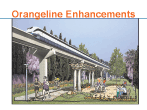By: Kirk Cartozian
California High Speed Rail will transform the lives of Central California businesses and landowners, not those living here in Southern California. Proponents of CHSR claim that a $10-billion bond being shouldered by taxpayers is fiscally prudent. Voters will decide if this is the case on November’s ballot.
A new mode of transportation and development that will dramatically transform the way that Southern Californians will live is in the planning stages. By contrast to California High Speed Rail’s “metal on metal” train proposal, the Orangeline’s plan is faster, quieter, more environmentally-friendly, and doesn’t call for the use of any state bond funding. In 2003, two LA County formed the Orangeline Development Authority. Their goal was to advance an innovative and futuristic approach to transportation while creating a demand for urban infill development. Today, with 14 member cities in 2008, the time is right for the general public to push forward as more and more cities continue to express interest in jumping aboard.
“Southern Californians have long relied on their automobiles’ false sense of security to get them from place to place,” said Kirk Cartozian, Chair, Orangeline Development Authority, who also serves as a Councilmember in the City of Downey. “Travel times and costs are now laughable topics in our society.” Talk is focused on the cost to “fill the tank,” as gasoline prices soar to new heights. Commuters are now more open to alternative modes of transportation. “It’s no longer about moving our cars faster, it’s about just moving people faster,” Cartozian expressed.
The core elements allowing such thought combine both transportation and urban development. “It is just as much about economic development as it is about transportation,” said Cartozian. The Orangeline High-Speed Maglev Authority marries transportation technology with infill planning concepts to develop transit-oriented community hubs around maglev station locations. It allows cities and other land-use authorities to indicate to the real estate community exactly where they want development to occur. In fact, cities are already re-designating their general plans to prepare for more intensity and density in these areas.
The Orangeline High-Speed Maglev Authority boldly proposes an elevated transportation system provided by advanced electromagnetic technology that floats or “levitates” above a fixed guideway, allowing it to travel at speeds of over 300 miles per hour. Maglev is a proven technology successfully operating all over the world, most notably in Shanghai, China. “Just think of the monorail at Disneyland zipping at half the speed of a jet plane in mid-flight,” Cartozian exclaimed. The concept is based on the physical properties of magnets that repel when placing similar polarities towards each other. The proposed Orangeline is capable of carrying both passengers and cargo along its 108-mile corridor. It is anticipated to run from central Orange County through downtown Los Angeles and Glendale up to the north county cities of Santa Clarita and Palmdale. The majority of the “right-of-ways” currently identified are abandoned and unused segments owned by the MTA, Union Pacific Railroad and OCTA. Caltrans corridors must also be petitioned for use.
Also unique about this project is that it would be developed using funding from private financing sources through a $19-billion Public-Private Partnership. The other hallmark of Orangeline is its comprehensive design of a mixed-use, transit-oriented development built around 18 commuter stations spaced approximately six miles apart.
The next steps that the Orangeline Development Authority is pursuing include the retention of a world-class law firm to help solicit and manage interest from potential investors and development partners, and completing and promoting a request for proposals from future Orangeline private partners.

The most advanced version of maglev technology in existence today is from Siemens. The vendor is Transrapid and today this is in operation in Shanghai, China. The Japanese (long noted for their advances in transportation) have committed to convert their high speed rail to maglev by 2025. See link to story: (http://telstarlogistics.typepad.com/telstarlogistics/2007/04/maglev_trains_t.html).
Kirk Cartozian, Chair, Orangeline Development Authority
Downey, CA 90241Tel 562.923.7900 office Fax 562.923.0600
Cell 562.852.1991 cell

|